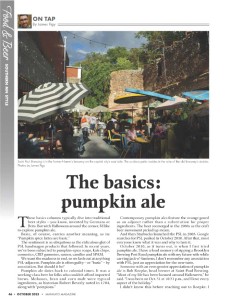
These basics columns typically dive into traditional beer styles — you know, invented by Germans or Brits. But with Halloween around the corner, I’d like to explore pumpkin ale.
Basic, of course, carries another meaning, as in: “Pumpkin spice lattes are basic.”
The sentiment is as ubiquitous as the ridiculous glut of PSL bandwagon products that followed. In recent years, we’ve been subjected to pumpkin-spice soaps, kale chips, cosmetics, CBD gummies, ramen, candles and SPAM.
We want the madness to end, so we lash out at anything PSL-adjacent. Pumpkin ale is often guilty — or “basic” — by association. But should it be?
RELATED: The Basics: Hefeweizen & The Basics: Pilsner
Pumpkin ale dates back to colonial times. It was a working-class beer for folks who couldn’t afford imported brews. Molasses, bran and corn malt were typical ingredients, as historian Robert Beverly noted in 1704, along with “pompions.”
Contemporary pumpkin ales feature the orange gourd as an adjunct rather than a substitution for proper ingredients. The beer reemerged in the 1980s as the craft beer movement picked up steam.

And then Starbucks launched the PSL in 2003. Google searches for PSL peaked in October 2010. After that, most everyone knew what it was and why to hate it.
October 2010, as it turns out, is when I first tried pumpkin ale. I have a fond memory of sipping a Brooklyn Brewing Post Road pumpkin ale with my future wife while carving jack-o’-lanterns. I don’t remember any association with PSL, just an appreciation for the new taste.
Someone with an even greater appreciation of pumpkin ale is Bob Roepke, head brewer at Saint Paul Brewing. “Most of my life has been focused around Halloween,” he said. “I was born on Oct. 31 at 10:31 p.m., and I love every aspect of the holiday.”
I didn’t know this before reaching out to Roepke. I simply wanted to talk to him because Mummy Train at Saint Paul Brewing (formerly Flat Earth Brewing Co.) is one of my favorite Minnesota pumpkin ales. After talking with him, it’s clear how much care goes into making this spooky seasonal.
James Figy: What really is a pumpkin ale?
Bob Roepke: A pumpkin ale is a beer that incorporates pumpkin as one of its main ingredients. To be considered a pumpkin ale, the beer should include real pumpkin, either in the mash, boil or added to the fermenter. Additionally, the beer can have the flavors and aromas of spices associated with pumpkin pie.
JF: Is the ale recipe fairly standard?
BR: There is no single standard recipe for pumpkin ale. The specific ingredients and brewing process can vary widely among different breweries. While the core components are typically malted barley, hops, yeast and pumpkin, the proportions and types of malt, hops and spices used can differ significantly from one brewer to another.
Some breweries opt for a more hop-forward pumpkin ale. Others focus on showcasing the pumpkin and spice flavors. I definitely choose the latter.

JF: What are the most common additional flavors?
BR: Some common extras or adjuncts include roasted pumpkin or pumpkin puree, honey, molasses, vanilla, maple syrup and cocoa nibs. A number of spices could be used, such as cinnamon, nutmeg, clove, ginger or allspice. Also, some pumpkin ales are barrel aged in oak.
JF: Where does Mummy Train sit on this continuum?
BR: Mummy Train is a fairly basic low-hop ale. That allows the pumpkin and spices to shine. The hops chosen complement the earthy notes from the pumpkin. It’s a medium-bodied beer with a dry finish to keep you going back for more.
JF: So, is it fair for people to lump pumpkin ale in with PSL?
BR: Absolutely not. They are not the same thing and should not be lumped together. Brewing beers with pumpkin and spices has been a tradition for centuries, especially in North America, where pumpkins are abundant during the fall season.
They may share the same flavors. But it’s important to recognize that a pumpkin ale is a beer crafted with real pumpkin and spices. The PSL is a coffee-based beverage with pumpkin spice syrup added.
JF: But is pumpkin ale, like PSL, fated to be forever stuck in autumn?
BR: Yes, pumpkin ale will always be associated with autumn. They typically get released in August and sold until about Thanksgiving. After that, they really don’t sell. So, if you would like to drink them all year-round, like I do, then you need to stock up and ration them throughout the year until next autumn.
James Figy is a writer and beer enthusiast based in St. Paul. In Mankato, he earned an MFA in creative writing from Minnesota State University and a World Beer Cruise captain’s jacket from Pub 500. Twitter and Instagram: @JamesBeered
This article originally appeared in the October 2023 issue of Mankato Magazine.
